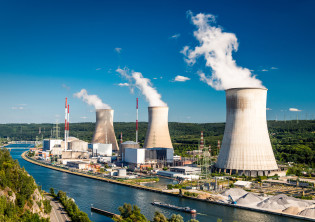Topics: Impacts and adaptation, Mitigation
Type: Briefing paper
Publication date: March 2018
Download
Summary
Authors: Neil Hirst

This briefing paper reviews the case for nuclear power as a part of the UK’s low carbon strategy, in the context of the global nuclear power industry and ongoing technological developments.
Headlines
- Nuclear power will be essential for meeting the UK’s greenhouse gas emissions reduction target, unless we can adapt to depend largely on variable wind and solar, or there is a breakthrough in the commercialisation of carbon capture and storage. The need may be greater if electricity becomes the preferred low-carbon solution for transport and heat.
- Investment in nuclear power is risky. Nuclear power stations take time to build and require heavy up-front investment, but should last for 60 years or more. In the US and Europe the cost of new builds has been high and construction performance troubled. As a result, it is difficult to attract private investment.
- We may regret building nuclear power stations if the cost of renewables continues to fall and we find solutions to the problem of the variability of these generation sources. On the other hand, if progress in reducing the costs of energy storage is insufficient, we may not be able to achieve climate targets without new nuclear generation capacity.
- Countries differ in their approach to nuclear power. The UK government’s decision to procure a 3.2GW nuclear power station (Hinkley Point C) is a big risk. However, it also represents a crucial opportunity for the conventional nuclear industry, which is under significant financial stress, to rebuild itself. The successful completion of Hinkley Point C and reductions in the cost of subsequent nuclear power stations will be critical for the future of the industry in the UK.
- Small modular reactors (SMRs), currently being assessed by the UK government, could be largely factory built and less prone to construction delays. Smaller unit size should make them easier to finance and more flexible to deploy.
- Advanced reactor concepts, including advanced SMRs, are under development for the longer term. These aim to deliver low-carbon energy solutions, such as high grade heat for industrial processes, as well as improved economics and safety.
Download: The role of nuclear electricity in a low-carbon world
View all Grantham Briefing Papers and Notes
[Image credit: Jotily]
View publications by:
Topic
Climate Science
Earth and Life Sciences
Energy and Low-Carbon Futures
Resources and Pollution
Economics and Finance
Health
View all publications and browse by year
Publication type
Briefing papers and Briefing notes
Grantham Institute Outlooks
Evidence & submission papers
Infographics
Institute reports and analytics notes
Grantham notes
Collaborative publications
Discussion papers
Institute event overviews
Working papers